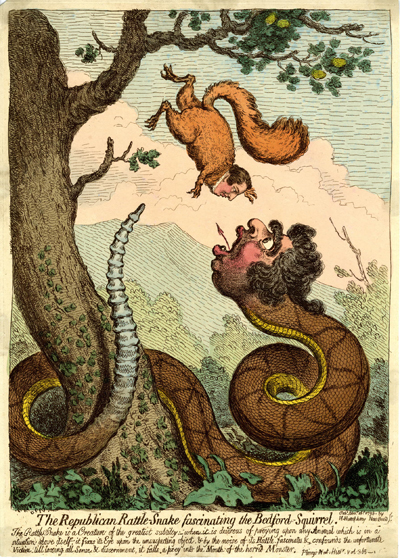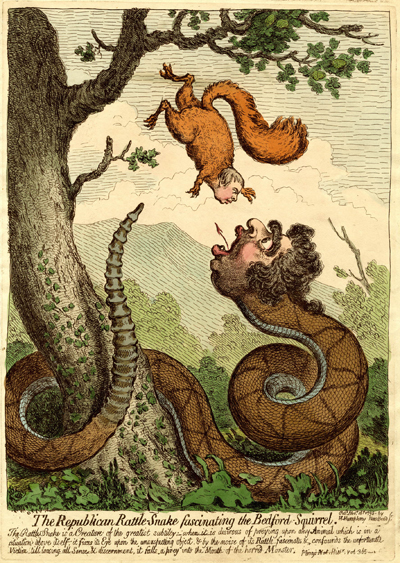The Republican Rattle-Snake Fascinating the Bedford-Squirrel
Ever since Pliny the Elder, who is referenced at the bottom of this print but is NOT the source of the subtitle, some snakes have been thought to have the power to mesmerize their victims. And thanks to both the exploration of, and more recently the war with, America, the American rattle snake had become a focus of attention, and was thought to possess such power.
For instance, Thomas Pennant (1726-1798), the Welsh naturalist, traveller and writer who is more likely to be a potential source of the print and subtitle wrote that
The rattlesnake will frequently lie at the bottom of a tree on which a squirrel is seated. He fixes his eyes on the animal, and from that moment it cannot escape; it begins a doleful outcry, which is so well known that a passerby, on hearing it, immediately knows that a snake is present. The squirrel runs up the tree a little way, comes down again, then goes up, and afterward comes still lower. The snake continues at the bottom of the tree with its eyes fixed on the squirrel, and his attention is so entirely taken up, that a person, accidentally approaching may make a considerable noise without so much as the snake turning about. The squirrel comes lower, and at last leaps down to the snake, whose mouth is already distended for its reception.**

© Trustees of the British Museum
Building upon popular conceptions such as this one, Gillray portrays Charles James Fox, the leader of the Whigs, as a combination of Satan and rattlesnake twined around a tree and "fascinating" the 30 year Francis Russell, 5th Duke of Bedford to support Whig/Republican measures that would lead to the death of the aristocracy he is supposed to represent.
By 1795, the Duke of Bedford had become Fox's virtual representative in the House of Lords, arguing in that chamber for the same approaches and policies that Fox supported in the House of Commons, including an immediate peace with France, and the opposition to the Treasonable and Seditious Practices act and the Seditious Meeting and Assembly act. And, as reported inThe Morning Chronicle on November 14th (p. 1), he was also the chairman of the Whig Club meeting held at the Crown and Anchor Tavern on November 11th that lamented the recent attack upon the King's carriage but resolved to oppose those bills that struck at "the Liberty of the Press and the Freedom of Public Discussion."
In some of the contemporary newspapers, Bedford was considered a simple pawn of Fox and Sheridan. An article in the The Tomahawk! or Censor General (11/13/1795) was headed "Duke or Dupe." A few days later (11/18/1785), the same source argued that Fox and Sheridan had seduced the Duke to their side by playing upon his vanity.
The Duke of Bedford is, though a very keen man in many things, the pigeon who is to be plucked on this occasion.. . . Perhaps there was never a deeper scheme taken, all in all, than this, of which Fox and Sheridan are the chiefs. They dupe the people by pretending to be serious, and they dupe the Duke of Bedford, by making him commit himself so far that his vanity, and fear of shame, will prevent him from drawing back when the Election comes.
But Bedford continued as the primary representative of Whig views in the House of Lords and was, in fact, portrayed as the ultimate Leviathan in Gillray's later apocalyptic print New Morality. . . (1798).
There are two versions of The Republican Rattle-Snake. . . with the same title and date differing only in the portrait of the Duke of Bedford. One seems to have darker hair, combed back; the other lighter hair combed forward. The darker haired, combed back version is much more common suggesting that it was the second state of the print; the image of the first having been rubbed out and replaced by the second.
It was Mathew Crowther who first noticed this in an article "Catching a Pair of Bedford Squirrels" published on his blog, The Printshop Window. There he argues that the darker-haired version is John Russell and that it would have replaced the first lighter-haired image of Francis Russell and been reissued sometime after 1806 when "John Russell [now the 6th Duke of Bedford] was serving in the government and constituted a target worth attacking."

© Trustees of the British Museum
There are two problems with this theory. First, it leaves unexplained why Gillray would have completed the much more difficult task of changing the face on the plate while neglecting the much easier fix of changing the date from 1795 to 1806. Second, it ignores the evidence of prints like The Generae of Patriotism (1796), French Habits No. 4 (1798) New Morality (1798), The Loyal Toast, The Affrighted Centaur (1799), and others, which all show Francis Russell the 5th Duke of Bedford, with dark hair, combed back and a straight nose similar to the dark-haired version of The Republican Rattle-Snake. Gillray prints with the Duke of Bedford after 1802 (when John became 6th Duke) such as Making Decent. . . (1806) and An Old English Gentleman. . . (1809) show a man whose hair is usually lighter than the earlier prints and always combed forward.
A simpler explanation of the two versions, then, could be this: in his first attempt, Gillray simply mistook John Russell for Francis Russell. The brothers were less than a year apart after all and this was the first time Gillray had included the Duke in a print. And once he realized his mistake, which would have been called to his attention very quickly, he would have corrected it. And that would account for the fact that the date remained the same.
** Quoted by James Bell Pettigrew in Design in Nature, Vol Two, p. 940.
Sources and Reading
- Commentary from the British Museum on The Republican Rattle-Snake Fascinating the Bedford-Squirrel
- "Charles James Fox," Wikipedia
- "Francis Russell, 5th Duke of Bedford," Wikipedia
- Thomas Wright and R.H. Evans, Historical and Descriptive Account of the Caricatures of James Gillray #136
Comments & Corrections
NOTE: Comments and/or corrections are always appreciated. To make that easier, I have included a form below that you can use. I promise never to share any of the info provided without your express permission.